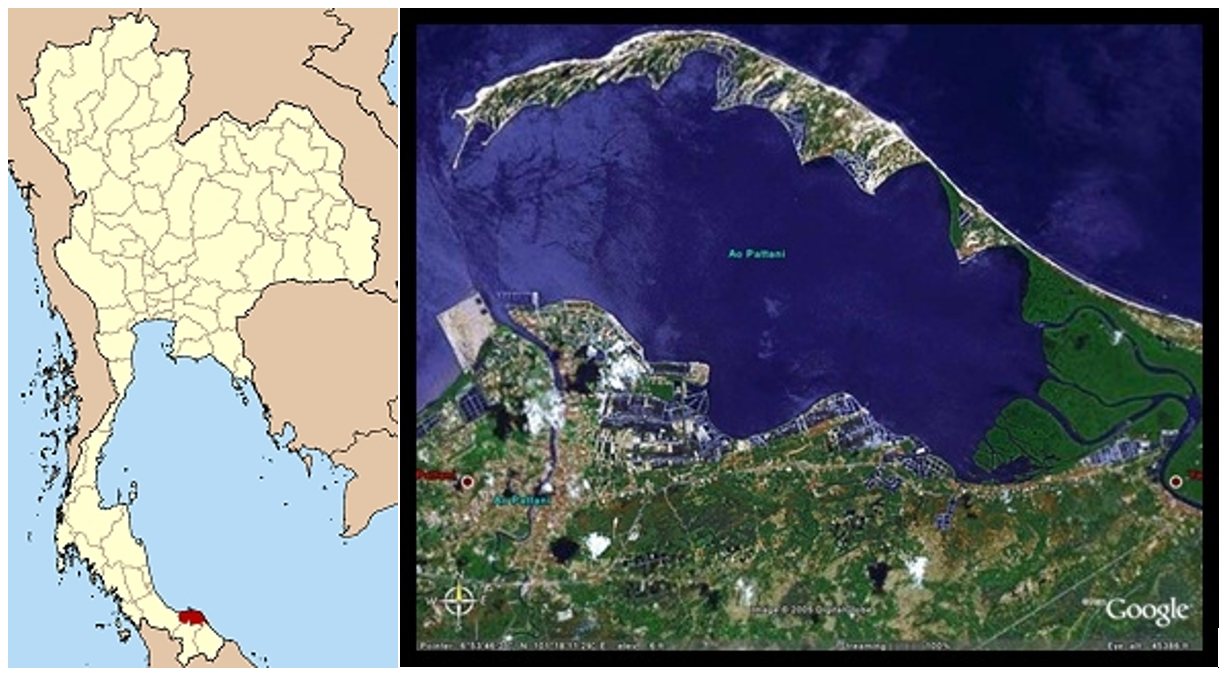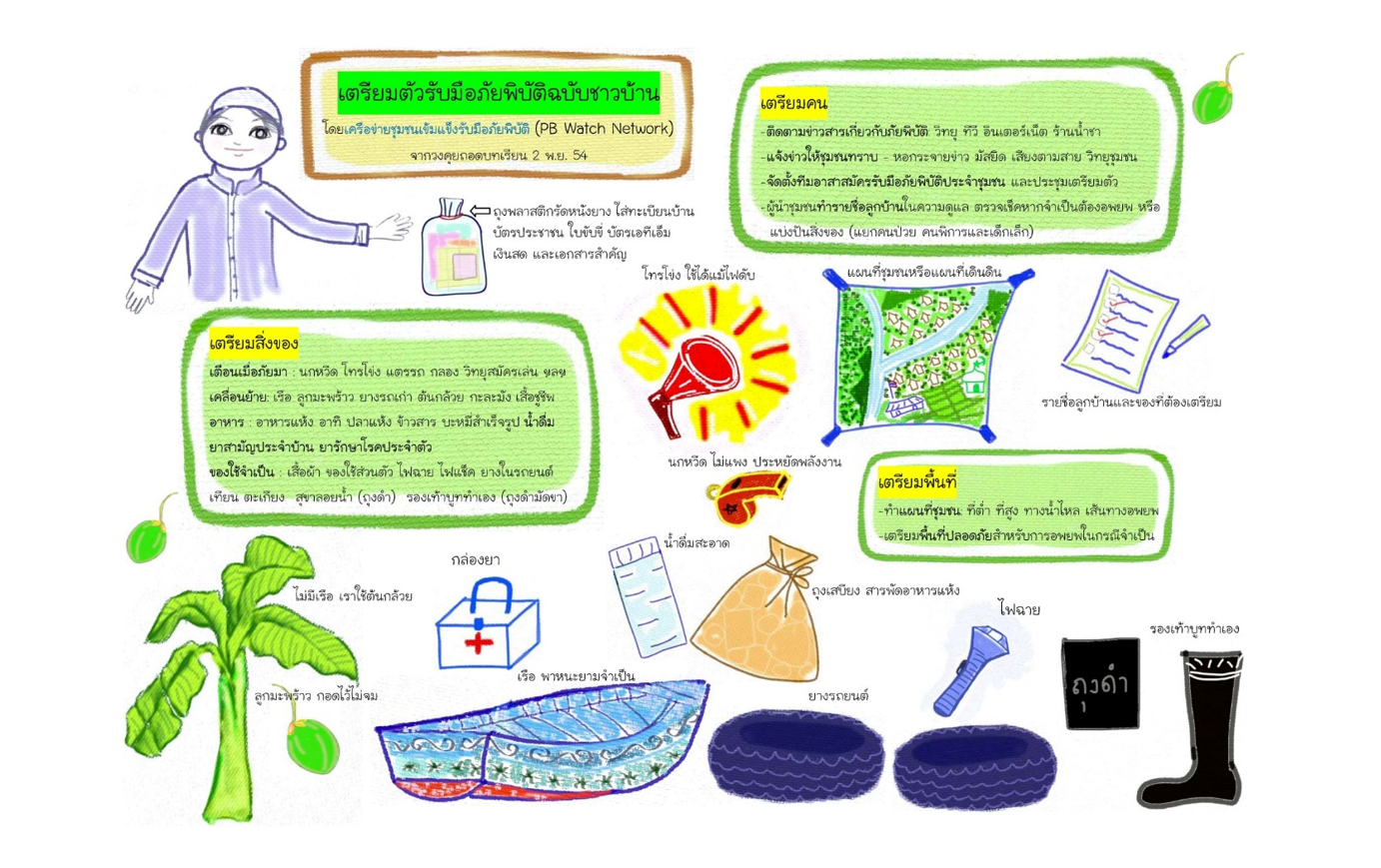PB Watch

History
Pattani Bay is the largest estuary bay in southern Thailand. It is a semi-closed elliptical shape with an outlet to the Gulf of Thailand on the west, which is connected to the mouth of the Pattani River. The bottom of the bay is the Yaring River mouth in the east. The north is a sandbar extending from the right bank of the Yaring River mouth, extending west in a curve for about 18 km, almost parallel to the mainland in the south of the bay. The bay covers an area of about 74 sq. km. It is the area with the highest concentration of fishermen in Thailand. There are 30 local fishing villages, with a total population of about 50,000 people.
The impact of the depression and the occurrence of the seiche wave on the coast of the Gulf of Thailand on November 1, 2010, caused damage from the strong winds and seawater that hit the shores of many coastal villages, especially those around Pattani Bay, causing complete or partial damage to fishing equipment and houses of the people (see Appendix A).
The disaster that occurred was widespread and severe. The unrest in the three southern border provinces has worsened the villagers’ lives.
However, it was found that the Pattani Bay Conservation Group, consisting of academics from the Faculty of Science and Technology and environmental NGOs, has been working with the villagers on conservation of public resources for sustainable development throughout the disaster recovery. This disaster recovery was able to intensively persuade 8 villages to join the project, and there were also 2 more communities in the Sai Buri River Basin that were also affected by the disaster, totaling 10.
After the incident, lecturers from the Faculty of Science and Technology, PSU Pattani, surveyed the area and found and “saw” many positive and negative social phenomena after the disaster. Negative phenomena include:
Lack of knowledge and understanding, lack of awareness, lack of mechanisms and plans to cope with the situation. Positive phenomena include mutual assistance within the community and network, cooperation between various government agencies, private organizations, and villagers, and the emergence of many volunteer groups. In addition, lessons, stories, experiences, and local knowledge from the incident were found, which can be used as capital for creating a community organization plan to cope with disasters in the future without being careless and as an opportunity to develop the community to be strong and self-reliant with dignity. Thai society has lessons and experiences from the tsunami area in Phang Nga Province. It can be concluded that the factor that makes the recovery from a large disaster go smoothly is the development of the potential of the affected groups to be able to mobilize and find ways to help themselves as much as possible. External assistance is a supplementary factor. Importantly, the strength of the community after the disaster is partly due to the work of private development organizations that help as mentors, ask questions, and encourage the community to find ways to help themselves as much as possible. From the disaster in Pattani Bay, the government has an urgent policy to help and restore the villagers to escape the damage. However, most state organizations are stuck in the bureaucracy and lack experience in empowering the villagers to help each other. The Community Development Organization Institute (CDO) is a public organization under the supervision of the government with the most experience in strengthening communities. It is one of the main organizations that helps restore strength in the tsunami area. Similarly, in the case of the disaster around Pattani Bay, CDO has a general mission to coordinate assistance and recovery, especially in finding temporary and permanent housing together with the poor people affected by the depression. On November 13, 2010, Prince of Songkla University, Pattani Campus, invited villagers from the villages affected by the disaster. Local NGOs and the Community Development Organization (CDO) met to find solutions to the situation in order to make the damage recovery process as efficient as possible.
The meeting agreed that urgent ways must be found to strengthen the community to be better than before by working together as a network with 3 important sectors: Prince of Songkla University, NGOs, and the disaster-affected communities. This is to make the community have the potential to be strong enough to cope with disasters that may occur again in the near future. The strengths include being able to control the situation and help themselves as much as possible and being able to manage the assistance received effectively.

Operation
Creating a mechanism for coordination of restoration within the area: Since the damage around Pattani Bay is extensive and there are many agencies that will provide assistance, both government and private sectors, as well as international organizations,
A temporary office for coordination is needed, which should be flexible. The meeting on 13 November 2010
considered that Prince of Songkla University, Pattani Campus, is the most appropriate organization and location. This institution will perform the following functions:
1. Create a mechanism to make information about the situation and assistance activities of various agencies in the area around Pattani Bay up-to-date at all times, easily accessible to all parties involved, and used by the community to monitor progress and used by assistance organizations to avoid duplication and complement each other’s activities.
2. Set up a temporary coordination office to be used as a meeting point between relevant groups, organize meetings, and disseminate information.
3. Find and coordinate mentors for the community in various activities related to restoration and development, such as administration, finance and accounting, engineering, and the environment, etc.
4. Create a learning process for all parties, including organizing students and young people in the area to participate in learning in various activities, including the relationship between problems in a holistic manner to create network relationships. At the same time, this is an opportunity to create a systematic mechanism that arises from the community’s self-reliance potential. To prepare for future disaster situations and to reduce and alleviate potential losses
5. Provide academics to conduct research necessary for recovery
6. Assist in providing information, knowledge, and lessons learned by creating a space for exchanging knowledge to create mutual understanding and awareness about disaster problems.
ข้อมูลการติดต่อ
โครงการพีบีวอทช์ (PB Watch) มอ.ปัตตานี
คณะวิทยาศาสตร์และเทคโนโลยี
มหาวิทยาลัยสงขลานครินทร์ วิทยาเขตปัตตานี
ผู้ประสานงานโครงการ :
hwanadenan@gmail.com (คุณวันอนันต์)
schuaiaree@gmail.com (อ.สมพร ช่วยอารีย์)
เว็บไซต์: www.pbwatch.net
